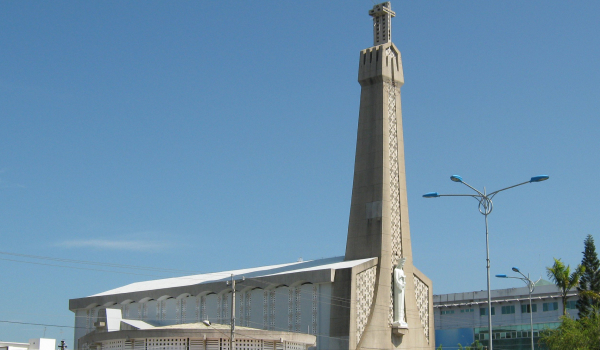
In a land area of 10,256 square kilometers, Long Xuyen diocese lying on the Mekong River Delta covers the territory of two provinces of An Giang and Kien Giang and the neighboring Can Tho City's districts of Thot Not and Vinh Thanh. It is bounded in the northwest by Cambodia, in the east by provinces of Dong Thap and Vinh Long, in the south by Can Tho city and in the west by Gulf of Thailand.
The total population of the diocesan territory is 4,174,409 as of the 2016. Long Xuyen diocese is a multi-ethnic and multi-religious region. The diocese is home to ethnic groups of Cham, Chinese and Khmer. It has Catholics from those ethnic groups.
Vietnamese is mainly spoken in the area. Other ethnic languages are only used within ethnic communities.
Long Xuyen diocese was carved out from Can Tho diocese and established on Nov. 24, 1960, when the Vietnam Church Hierarchy was established. It belongs to Ho Chi Minh City Ecclesiastical Province.
The late Bishop Michael Nguyen Khac Ngu became the first bishop of the diocese. Bishop Ngu built the Queen of Peace Cathedral, St. Therese Minor Seminary, St. Thomas Major Seminary, 60 schools and many centers for welfare services. The number of local Catholics increased dramatically after 1954 when tens of thousands of Catholics from northern dioceses fled to following French troops' defeat in the north. In 1964, the diocese had 93,739 Catholics among the population of 1,252,705, served by 107 priests, 191 Religious and 59 major seminarians.
After 1975, when the country was reunified under communist rule, all Church-run facilities were confiscated by the government.
Cu Lao Gieng church built in 1889 is one of the diocese's oldest churches. The tomb of Martyr Emmanuel Le Van Phung, a lay leader who was killed for his faith on July 31, 1859, is kept in the church. Many local Catholics visit and pray in front of his tomb.
Bishop Joseph Tran Xuan Tieu gives priorities to urge local Catholics to express solidarity with one another, to work with people of other faiths and have dialogs with atheists through charitable activities. He said there are many faiths and ethnic groups in his diocese so local Catholics try to love, respect and live in harmony with one another and other people regardless of their backgrounds.
The diocese promotes re-evanglization work among local Catholics by giving them faith education and training lay leaders and catechists. The local Church also serves and evangelizes local people, especially poor people, and erects mission stations.
Main transportation includes airplanes, boats, buses, bicycles and motorbikes. Rach Soi Domestic Airport is the only airport located in Rach Gia city. The area is crisscrossed by rivers, canals and drains.
The average temperature in the area is 27 degrees centigrade. There are two seasons - rainy and dry ones.
An Giang province's average annual rainfall is 1,130 millimeters. The rainy season is from May to November. The temperature reaches a maximum in April, up to 38 degrees centigrade.
Kien Giang's average annual rainfall is 1,600-2,000 millimeters, especially the district of Phu Quoc has an annual rainfall of 2,400-2,800 millimeters. The rainy season is from April to November.
The diocese is one of main areas producing rice in the Mekong Delta. Local people mainly are farmers cultivate rice. Others make incense sticks, rice papers and leave hats, produce fishing boats and fish nets, and raising pigs, duck, chicken, shrimps and fishes.
The area is famous for cho noi or markets on rivers and canals where people travel by boat to sell and buy agricultural products. Cho Noi Long Xuyen is the biggest where hundreds of boats from various places gather for trade every day from 6 a.m. to 6 p.m.
The area is known for its special foods such as nuoc mam or fish source in Phu Quoc and dried fish in An Giang.
The area is the home to Hoa Hao, a Buddhist sect. Its followers predominate in the area. Followers of Hoa Hao live in harmony with Catholics and work with Catholics to provide foods and health care for poor people, and build bridges over canals.
Other indigenous faiths include Cao Ðài, a syncretic belief system, and Tu An Hieu Nghia. Most ethnic Cham people are followers of Islam. Others are Buddhists.